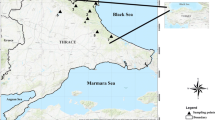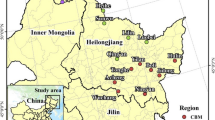Abstract
Context
Information about variations in basic density (BD) and carbon content (%C) along tree stems is key to assessing forest carbon sinks.
Aims
The aim of the study was to determine any differences in %C and BD between different woody tissues (bark, sapwood and heartwood) in two widespread European oak species (Quercus pyrenaica and Quercus petraea).
Methods
Twenty trees were felled in northern Spain, and 317 discs cut from the trees were dried and analysed to determine %C and BD.
Results
There were significant differences in %C between bark, heartwood and sapwood, and between species. There were also significant differences in BD between the tissues (heartwood > sapwood > bark), and the BD was higher in Q. petraea than in Q. pyrenaica. Both %C and BD varied along the stem.
Conclusion
More accurate estimates of carbon contents were obtained by using specific values for different heights and anatomical parts, than by using single values.




Similar content being viewed by others
References
Adame P, Cañellas I, Roig S, Del Río M (2006) Modelling dominant height growth and site index curves for rebollo oak (Quercus pyrenaica Willd.). Ann For Sci 63:929–940
Alcalde Crespo G (2001) Guardo-Cervera. Ediciones Cálamo, Palencia
Bergès L, Nepveu G, Franc A (2008) Effects of ecological factors on radial growth and wood density components of sessile oak (Quercus petraea Liebl.) in Northern France. For Ecol Manag 255:567–579
Bert D, Danjon F (2006) Carbon concentration variations in the roots, stem and crown of mature Pinus pinaster (Ait.). For Ecol Manag 222:279–295
Bravo-Oviedo A, Sterba H, Del Río M, Bravo F (2006) Competition-induced mortality for Mediterranean Pinus pinaster Ait. and P. sylvestris L. For Ecol Manag 222:88–98
Campbell AG, Kim WJ, Koch P (1990) Chemical variation in lodgepole pine with sapwood/heartwood, stem height, and variety. Wood Fiber Sci 22:22–30
Canadell JG, Raupach MR (2008) Managing forests for climate change mitigation. Science 320:1456–1457
Clifton DS, Bulpitt WS, Birchfield JL, Brown ML, Chiang TI, Day SW, Dixit BS, Gibson NS, McGowan TF (1979) A feasibility study for wood energy utilization in Georgia. Georgia Institute of Technology. Final Report, Athens
Climent JA, Gil L, Pardos JA (1998) Xylem anatomical traits related to resinous heartwood formation in Pinus canariensis Sm. Trees 12:139–145
Correia AC, Tomé M, Pacheco CA, Faias S, Dias AC, Freire J, Carvalho PO, Pereira JS (2010) Biomass allometry and carbon factors for a Mediterranean pine (Pinus pinea L) in Portugal. For Sys 19:418–433
Costa M, Morla C, Sainz H (2005) Los Bosques Ibéricos. Una interpretación geobotánica. Ed, Planeta, Barcelona
Elliot RN (1980) Wood combustion. In: Levi MP, O’Grady MJ (eds) Decisionmaker’s guide to wood fuel for small industrial energy uses. Solar Energy Research Institute, Golden, Colorado (USA), pp 31–54
FIMCI (2003) Intensive Monitoring of Forest Ecosystems in Europe: Technical Report. Amsterdam
Fukatsu E, Fukuda Y, Takahashi M, Nakada R (2008) Clonal variation of carbon content in wood of Larix kaempferi (Japanese larch). J Wood Sci 54:247–251
Guilley E, Nepveu G (2003) Interprétation anatomique des composantes d’un modèle mixte de densité du bois chez le Chêne sessile (Quercus petraea Liebl.): âge du cerne compté depuis la moelle, largeur de cerne, arbre, variabilité interannuelle et duraminisation. Ann For Sci 60:331–346
Guilley E, Hervé JC, Nepveu G (2004) The influence of site quality, silviculture and region on wood density mixed model in Quercus petraea Liebl. For Ecol Manag 189:111–121
Henry M, Besnard A, Asante WA, Eshun J, Adu-Bredu S, Valentini R, Bernoux M, Saint-André L (2010) Wood density, phytomass variations within and among trees, and allometric equations in a tropical rainforest of Africa. For Ecol Manag 260:1375–1388
Herrero C, Turrión MB, Pando V, Bravo F (2011) Carbon in heartwood, sapwood and bark along the stem profile in three Mediterranean Pinus species. Ann For Sci 68:1067–1076
Hosmer DW, Lemeshow S (2000) Applied logistic regression. Wiley, New York
Houghton JT, Jenkins GJ, Ephraums JJ (eds) (1990) Climate change. The IPCC scientific assessment. Cambridge University Press, Cambridge
Huet S, Forgeard F, Nys C (2004) Above and belowground distribution of dry matter and carbon biomass of Atlantic beech (Fagus sylvatica L.) in a time sequence. Ann For Sci 61:683–694
Khattree R, Naik DN (1995) Applied multivariate statistics with SAS Software. SAS Institute Inc., Cary, NC
Lamlom SH, Savidge RA (2003) A reassessment of carbon content in wood: variation within and between 41 North American species. Biomass Bioenerg 25:381–388
Löwe H, Seufert G, Raes F (2000) Comparison of methods used within Member States for estimating CO2 emissions and sinks according to UNFCCC and EU Monitoring Mechanism: forest and other wooded land. Biotechnol Agron Soc Environ 4:315–319
Magel EA, Monties B, Drouet A, Jay-Allemand C, Ziegler H (1995) Heartwood formation: biosynthesis of heartwood extractives and “secondary” lignification. In: Bonnet-Masimbert M (ed) Sandermann H. Contribution to Forest Tree Physiology. EUROSILVA. INRA, Paris, pp 35–56
Nabuurs GJ, Masera O, Andrasko K, Benitez-Ponce P, Boer R, Dutschke M, Elsiddig E, Ford-Robertson J, Frumhoff P, Karjalainen T, Krankina O, Kurz WA, Matsumoto M, Oyhantcabal W, Ravindranath NH, Sanz Sanchez MJ, Zhang X (2007) Forestry. In: Metz B, Davidson O, Bosch P, Dave R, Meyer L (eds) Climate Change 2007: Mitigation. Contribution of Working Group III to the Fourth Assessment Report of the Intergovernmental Panel on Climate Change Cambridge University Press, Cambridge (UK), pp 541–584
Neter J, Maynes SE (1970) On the appropriateness of the correlation coefficient with 0,1 dependent variable. J Am Stat Assoc 65:501–509
Nogueira EM, Fearnside PM, Nelson BW (2008) Normalization of wood density in biomass estimates of Amazon forests. For Ecol Manag 256:990–996
Peri PL, Gargaglione V, Martínez-Pastur G, Lencinas MV (2010) Carbon accumulation along a stand development sequence of Nothofagus antarctica forests across a gradient in site quality in Southern Patagonia. For Ecol Manag 260:229–237
Ravindranath NH, Ostwald M (2008) Carbon inventory methods—handbook for greenhouse gas.Carbon Mitigation and Roundwood Production Projects. Springer, New York
Reque JA (2008) Selvicultura de Quercus petraea L. y Quercus robur L. In: Serrada R, Montero G, Reque JA (eds) Compendio de Selvicultura aplicada en España. MMA-INIA, Madrid, pp 745–772
Roderick ML (2000) On the measurement of growth with applications to the modelling and analysis of plant growth. Funct Ecol 14:244–251
Sabaté S, Gracia C, Sánchez A (2002) Likely effects of climate change on growth of Quercus ilex, Pinus halepensis, Pinus pinaster, Pinus sylvestris and Fagus sylvatica forests in the Mediterranean region. For Ecol Manag 162:23–37
SAS Institute Inc. (2004). SAS/STAT 9.1 User’s Guide. SAS Institute Inc., Cary, NC
Simpson WT (1993) Specific gravity, moisture content, and density relationship for wood. General Technical Report FPL-GTR-76. U.S. Department of Agriculture, Forest Service, Forest Products Laboratory, Madison, USA
Thomas SC, Malczewski G (2007) Wood carbon content of tree species in Eastern China: interspecific variability and the importance of the volatile fraction. J Environ Manage 85:659–662
Timbal J, Aussenac G (1996) An overview of ecology and silviculture of indigenous oaks in France. Ann Sci For 53:649–661
Torre M (1994) Degradación inducida por algunas prácticas agrarias tradicionales. El caso de los rebollares (Quercus pyrenaica Willd.) de la provincia de León. PhD Thesis. ETSIMO-UPM, Madrid (unpublished)
Venables WN, Ripley BD (1999) Modern applied statistics with S-PLUS. Springer, New York
Wenzl HF (1970) The chemical technology of wood. Academic, New York
Zabek LM, Prescott CE (2006) Biomass equations and carbon content of aboveground leafless biomass of hybrid poplar in Coastal British Columbia. For Ecol Manag 223:291–302
Zhang SY, Nepveu G, Mothe F (1994) Modelling intratree wood shrinkage in European oak by measuring wood density. For Prod J 44:42–46
Zhang Q, Wang C, Wang X, Quan X (2009) Carbon concentration variability of 10 Chinese temperate tree species. For Ecol Manag 258:722–727
Zobel BJ, Van Buijtenen JP (1989) Wood variation: its causes and control. Springer, Berlin
Acknowledgements
The authors thank Celia Herrero de Aza and Cristobal Ordóñez (Sustainable Forest Management Research Institute UVa-INIA) for their valuable comments, Juan Carlos Arranz from University of Valladolid for assistance with LECO analysis, and Sayfor S.L. for invaluable help during sampling in the field. Special thanks to Christine Francis for revising the English of the manuscript and especially to Dr. Marcos Barrio Anta for his invaluable suggestions during revision of the manuscript.
Funding
This worked was funded by the University of Valladolid.
Author information
Authors and Affiliations
Corresponding author
Additional information
Handling Editor: Barry Alan Gardiner
Contribution of the co-authors
Javier Castaño-Santamaría: carried out the laboratory analyses, ran the data analysis, wrote the manuscript and corrected the referees’ comments and editor’s comments in the following versions of the manuscript.
Felipe Bravo: designed the experiment, supervised the work and corrected the first version of the manuscript.
Rights and permissions
About this article
Cite this article
Castaño-Santamaría, J., Bravo, F. Variation in carbon concentration and basic density along stems of sessile oak (Quercus petraea (Matt.) Liebl.) and Pyrenean oak (Quercus pyrenaica Willd.) in the Cantabrian Range (NW Spain). Annals of Forest Science 69, 663–672 (2012). https://doi.org/10.1007/s13595-012-0183-6
Received:
Accepted:
Published:
Issue Date:
DOI: https://doi.org/10.1007/s13595-012-0183-6




